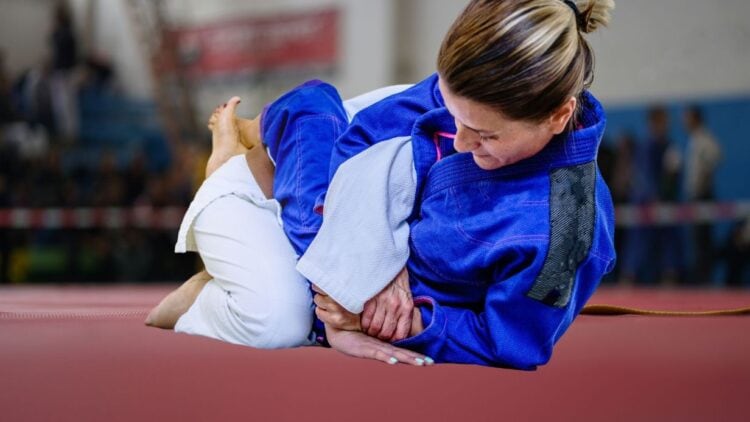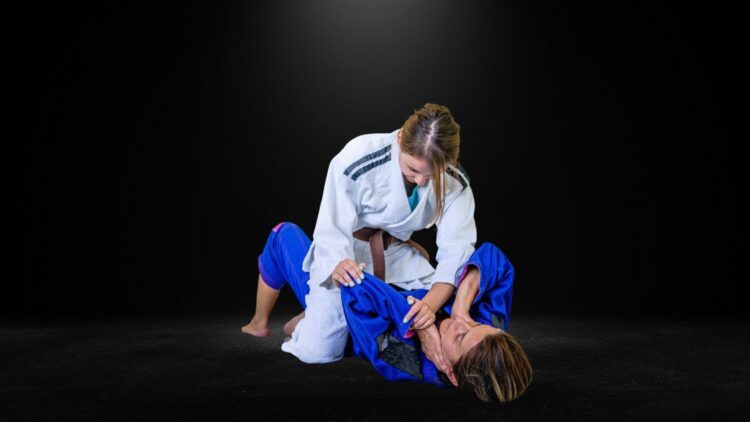
With the popularity explosion of Brazilian jujutsu (BJJ) in recent decades, most people are unaware of what traditional “Japanese” jujutsu even is. Although both are relatively similar fighting styles, their utilities and competitive scenes are vastly different. In this article, we will compare Brazilian jujutsu (BJJ) and Japanese jujutsu, breaking down all the differences and similarities. Let’s dive straight in!
SIMILARITIES

Before we jump into the differences, let’s first highlight what is similar. As you may be able to guess, jujutsu originated long before the development of Brazilian jujutsu. However, interestingly enough, BJJ didn’t directly develop out of jujutsu. Instead, BJJ is based on the martial art of judo—which is based on traditional jujutsu. So, you can think of Brazilian jujutsu as the grandchild of jujutsu rather than an offspring.
Therefore, although the two jujutsu styles share many similarities, BJJ is slightly more similar to judo than it is to jujutsu.
The similarities shared between BJJ and jujutsu are as follows:
1) Both sports make use of similar combat techniques
In both jujutsu disciplines, fighters utilize many of the same techniques, such as throws, ground fighting, and grappling. However, the extent to which each of these skills is used differs between the two sports.
2) Fighters in both sports wear the same uniform
Most Japanese martial arts (jujutsu being one) require fighters to wear traditional robe-like uniforms known as “gi”. Although BJJ developed in Brazil, as evidenced by its name, this traditional attire has remained chiefly in practice. With that said, BJJ is more lenient on uniform requirements, and some events allow fighters to wear traditional MMA attire instead of a gi. Additionally, both sports use colored belts to signify a fighter’s skill level.
3) Both sports are fundamentally based on self-defense
Although jujutsu was initially developed for offensive and defensive war-time purposes, its modern use is almost solely that of defense. BJJ, meanwhile, is considered one of the most practical and efficient forms of self-defense training in the world.
4) The primary objective in each sport is to subdue/submit the opponent
As both martial arts are based on self-defense, each aims to subdue an attacker. Fighters can do this with several different joint-locking techniques or chokes.
DIFFERENCES
While Brazilian jujutsu (BJJ) and jujutsu may sound the same, they are, in fact very different sports with varying sets of rules and regulations. Here are the main differences between BJJ and jujutsu.
EVENTS
BRAZILIAN JUJUTSU

Competitively, most BJJ events are similar to most other combat sports: one-on-one matchups in which one fighter wins by either submitting their opponent or earning the most points. These fights range in length from 5 to 10 minutes, depending on the fighters’ skill level (belt color).
JUJUTSU
While jujutsu does have a form of combat fighting that is similar to BJJ (known as “freefighting” or “contact jujutsu”), this style of jujutsu competition is extremely rare nowadays, especially in the West. The main reason for this is that most traditional jujutsu techniques were developed to actually injure, paralyze, or even kill an adversary. As a result, modern jujutsu fights generally can’t be authentic to the true nature of the sport.
Instead of traditional fights, most jujutsu competitions are done as performative routines. These events are often known as “duos” and feature two (sometimes more) teammates—one assuming the role of the attacker and the other the role of the defender—showcasing a display of various jujutsu techniques and combos. These routines usually involve some degree of improvisation, as judges will usually call out a certain type of attack that the defending fighter must react to. Of course, these routines are friendly performances.
SCORING
BRAZILIAN JUJUTSU
In a BJJ match, fighters can win by submitting their opponent (forcing them to tap out) or by accumulating the most points by the end of the match. These points can be scored with the successful use of various techniques, including:
- Takedown (2 points) – Bringing a standing opponent to the ground
- Sweep (2 points) – Switching places with an opponent who is on top and maintaining that new top control position
- Knee-on-belly (2 points) – Placing a knee on the opponent’s stomach on the ground
- Guard passing (3 points) – Getting past the opponent’s guard position, such as swiping their knees out of the way when they’re being used to keep distance between the two fighters.
- Full mount (4 points) – Laying directly on top of their opponent’s torso
- Back mount (4 points) – The same as the above, except the fighter on the bottom is lying on their stomach
The fighter must maintain these positions for at least three seconds to gain points (with the exception of takedowns and guard passes).
JUJUTSU

In contact jujutsu, fighters determine the match with a submission or knockout. However, matches can also be decided by points or the referee’s decision.
- Submission: Just like in BJJ, a submission is scored immediately ends the match and is scored whenever a fighter forces their opponent to tap out. This often results from being put in a chokehold or a painful joint lock. A submission that results in a fighter losing consciousness is automatically considered a submission. Furthermore, any sort of outcry or scream of pain is considered a surrender.
- Knockout: A knockout occurs when a fighter is knocked to the ground and unable to get up after a three-second count. If the fighter gets up before the three-second count is complete, it will be immediately considered a knockout if they get knocked to the ground again in a similar manner.
- Points/Referee’s decision: Referees keep track of various effective techniques used by each fighter during a match. These points are factored in with the referee’s overall impression of the match (such as each fighter’s passivity) to determine the winner if no submission or knockout occurs.
In jujutsu duo performances, fighters are scored as pairs by a panel of judges based on their performance. Each pair of teammates are scored from 0 to 10, with this final score being influenced by the speed, accuracy, control, and realism of the performance.
RULES
Brazilian jujutsu and combat jujutsu share many of the same rules, many of which concern safety. This means that many of the same dangerous chokes, joint locks, and other techniques that intentionally cause unnecessary harm or risk of injury are prohibited.
Apart from safety, one major rule difference exists between these two sports: jujutsu allows the use of strikes (kicks, punches, knees, elbows, etc.), while BJJ allows nothing of the type (other than leg sweeps, which aren’t considered a kick). This is a significant difference, as it is the primary reason why BJJ is focused almost entirely on ground fighting while jujutsu consists of a healthy mix of standing and ground fighting.
UTILITY/POPULARITY
Since it was developed as a wartime combat style, traditional jujutsu is somewhat obsolete in modern times. After all, safety is a major component of any modern sport, and jujutsu was fundamentally supposed to be the opposite of safe. Instead, jujutsu is now embraced solely as a martial art, not necessarily a competitive sport (hence, the performative displays). As a result of this transition, jujutsu isn’t well-understood around the world, with it instead being kept alive by those fascinated by its long-standing history.
On the other hand, Brazilian jujutsu has been growing exponentially in popularity in the West, especially in the United States. Much of this growth has to do with the fact that BJJ techniques are relatively easy to learn and are effective in nearly any situation while used by just about any person. Furthermore, BJJ techniques aren’t necessarily intended to cause severe bodily harm. Because of this, many people don’t only practice BJJ for self-defense purposes but also as a daily form of exercise.
However, it’s worth noting that modern competitive jujutsu styles have also evolved over the years. These modern jujutsu styles may emphasize self-defense, grappling, and ground fighting, similar to BJJ.
OVERALL COMPARISON
Like most martial arts, many similarities exist between Brazilian jujutsu and traditional jujutsu. Both use similar techniques, with the main ones being grappling, ground fighting, throws, and various submission techniques (choking, joint locks). Furthermore, despite its Brazilian influence, BJJ still honors many Japanese traditions that are present in jujutsu and other Japanese martial arts, such as the wearing of the gi, the use of colored belts to signify rank, and forms of pre- and post-match gestures of respect between opponents.
In many ways, the main differences between these two jujutsu disciplines result from BJJ simply being a modernized version of traditional jujutsu. After all, BJJ was developed so that the average person could learn how to efficiently defend themself, while normal jujutsu was developed nearly 500 years ago as a form of combat training for highly skilled Japanese samurai.
While it is unlikely that jujutsu will ever surge to prominence again, Brazilian jujutsu is only expected to keep growing in popularity at a profound rate.
- 30 GAMES TO PLAY OVER TEXT - April 22, 2024
- 20+ FREE PRINTABLE BABY SHOWER GAMES - April 16, 2024
- 20+ College Party Games for the Best Night Ever! - April 2, 2024